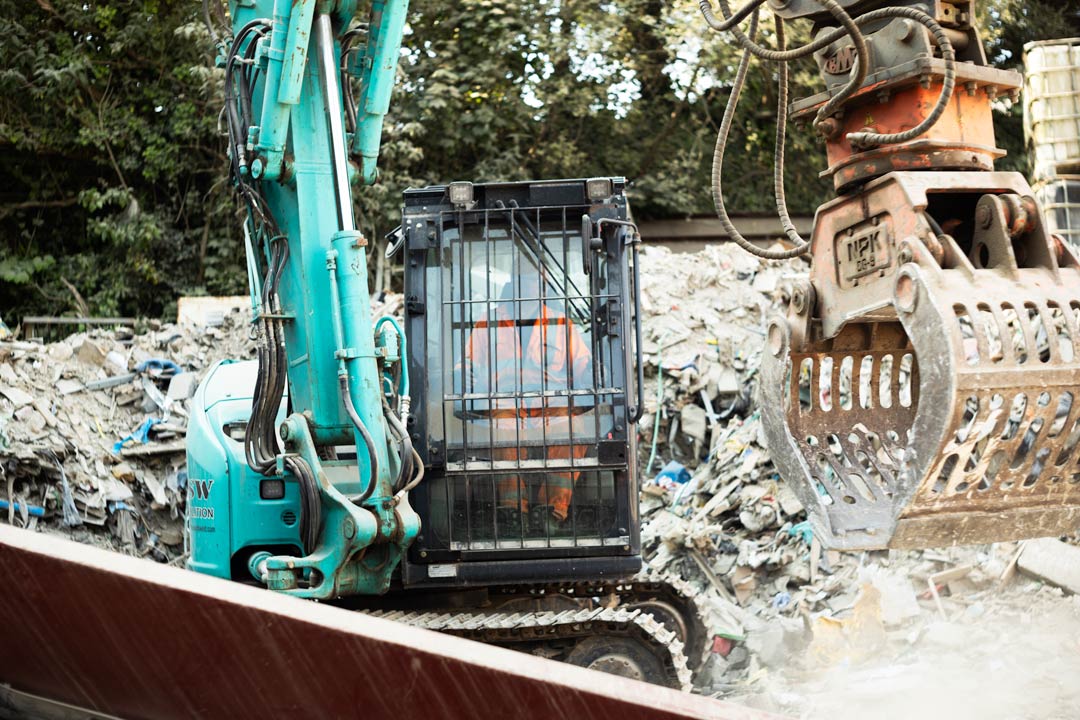In the UK, waste transfer stations, such as DSW’s in St Dennis, Cornwall, play a critical role in the waste management process by serving as an intermediary point where waste is collected, sorted, and then sent for recycling, treatment, or disposal. The operation of a waste transfer station involves several steps to ensure that waste is processed efficiently and in an environmentally responsible way. Here’s an overview of how waste is collected, sorted, and processed at a lot of waste transfer stations in the UK:
1. Collection of Waste at the Station
Waste transfer stations receive waste from various sources, including:
- Local authorities: Collected from households during routine bin collections (recycling, general waste, and organic waste).
- Commercial and industrial sources: Businesses, construction sites, and other organisations may deliver waste directly to transfer stations or use skip hire companies to transport it.
- Private contractors: Many waste transfer stations work with private contractors, including skip hire services, who collect waste from homes, construction sites, or businesses.
Upon arrival at the station, vehicles are weighed to record the amount of waste they are carrying. They are then directed to designated areas based on the type of waste they’re delivering (general waste, recyclables, hazardous waste, etc.).
2. Initial Sorting of Waste
Once collected, the waste undergoes an initial sorting process to separate recyclable materials from non-recyclables. The sorting process varies depending on the facility and the type of waste, but generally involves several steps:
- Manual Sorting: Some transfer stations employ workers to manually sort through waste, removing large recyclable items like cardboard, plastic, metals, or items unsuitable for landfill, such as hazardous waste.
- Mechanical Sorting: Automated systems may be used to help separate different types of waste. This could include conveyor belts, magnets, shredders, and trommels (large rotating drums) to sort out materials by size, shape, weight, or type.
Types of Waste Sorted:
- Recyclable materials: Plastics, metals, paper, glass, and cardboard are sorted for recycling.
- Green waste: Organic matter like grass clippings, leaves, and food waste may be separated for composting or anaerobic digestion.
- Construction and demolition waste: This includes materials like rubble, wood, and metal, which are often sorted separately for recycling or reuse in construction.
- Hazardous waste: Materials like batteries, chemicals, or asbestos are carefully separated and stored for safe disposal in compliance with regulations.
3. Further Processing and Segregation
After the initial sorting, waste undergoes further separation processes to refine the sorting and maximise recovery of recyclable materials. Here are some common methods used:
- Magnets: Ferrous metals (like steel) are removed using powerful magnets.
- Eddy Current Separators: These machines help to separate non-ferrous metals (such as aluminium) from other waste streams.
- Air Classifiers: Lightweight materials, like paper or plastic, are blown into separate containers using high-powered air jets.
- Optical Sorting: Advanced systems use sensors and light to identify and separate different types of plastics or other recyclable materials.
- Shredders and Crushers: Large materials are broken down into smaller pieces, making it easier to sort and recover materials.
4. Storage and Transfer for Recycling or Disposal
Once the sorting process is complete, different types of waste are stored in separate areas for further processing or transportation:
- Recyclable Materials: Items such as metals, plastics, and glass are baled or compacted and then transported to recycling facilities where they are reprocessed into new materials.
- Green Waste: Organic waste is usually sent to composting facilities or anaerobic digestion plants where it is converted into compost, biogas, or biofertilizer.
- Non-Recyclable Waste: Residual waste that cannot be recycled is typically sent to energy-from-waste (EfW) plants, where it is incinerated to generate electricity, or to landfill if no other option is viable.
- Hazardous Waste: Materials that are classified as hazardous (e.g., chemicals, asbestos) are stored separately and disposed of at specialised hazardous waste facilities.
5. Waste Monitoring and Compliance
At every stage of the process, waste transfer stations must adhere to strict environmental and safety regulations set by government bodies such as the Environment Agency. Waste is tracked and recorded to ensure that materials are handled correctly, especially hazardous waste, which requires special permits and disposal methods.
- Weighbridges: These are used to weigh waste arriving at and leaving the transfer station, helping track the amount of waste processed.
- Waste Transfer Notes: Each load of waste is accompanied by documentation that records its source, type, and destination. This ensures transparency and compliance with UK waste management regulations.
6. Final Disposal and Recycling
After sorting, processing, and storing, waste is either sent to recycling plants or, in the case of non-recyclable waste, for final disposal. In the UK, the emphasis is on diverting waste from landfill, so a significant portion of residual waste is now sent to energy-from-waste (EfW) facilities, where waste is burned to generate electricity and heat. At DSW we are committed to zero landfill from our waste transfer station.
Conclusion
In the UK, waste transfer stations are designed to maximise recycling, reduce landfill use, and ensure that waste is processed in an environmentally responsible manner. By using a combination of manual and mechanical sorting methods, waste is separated into recyclable materials, organic waste, hazardous waste, and non-recyclables. The use of skips and private contractors helps to streamline the collection of larger volumes of waste, especially from construction and household projects. Ultimately, waste transfer stations play a key role in the UK’s broader efforts to promote sustainable waste management practices.


